The AMS announced this week that William B. Gail is the new AMS president-elect and will take over as the Society’s president in January of 2014.
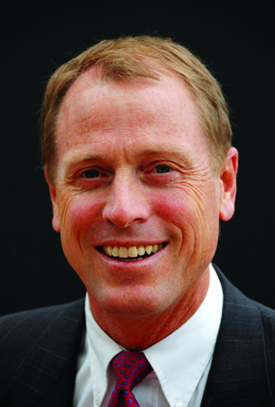
Gail is cofounder and chief technology officer of Global Weather Corporation (GWC), a Boulder, Colorado, company that provides precision forecasts to businesses serving weather-sensitive sectors, such as wind energy, transportation, and media. He founded GWC to broaden the public benefit from next-generation forecast technologies being created in universities and national labs. Prior to founding GWC, he was a director at Microsoft, where he was responsible for software innovation such as consumer mobile and 3D weather visualization.
Recently, Gail has been a leader in the call for a U.S. Weather Commission, which would utilize the weather expertise of the meteorological community to advise federal policymakers on forecasting and making the country more weather-ready. He contributed to the NAS/NRC report “Weather Services for the Nation: Becoming Second to None,” and he was a member of a panel that recently spoke to Congress about this topic; he can be seen in this video of the panel, beginning at the 13:15 mark. (The U.S. Weather Commission will be the focus of a Town Hall Meeting at the upcoming AMS Annual Meeting in Austin.)
Newly elected AMS Councilors for 2012 were also announced: Stephen F. Corfidi of the Storm Prediction Center, Sonia Kreidenweis of Colorado State University, Frank D. Marks of the Atlantic Oceanographic and Meteorology Laboratories, Yvette P. Richardson of The Pennsylvania State University, and Elizabeth A. Ritchie of the University of Arizona.
News
Barack, Mitt . . . and Sandy
In the modern era of presidential campaigns, even with candidates’ every last word and action carefully scripted, there can still be surprises. This year, that surprise came in the form of an interloper named Sandy, a blustery blowhard whose campaign stormed up the East Coast and made bombastic statements all along the way, treating red and blue states with equal disrespect. In the process, Sandy emphatically impacted the race for the presidency. First, she forced both President Obama and Mitt Romney to alter their campaigns while she commanded the attention of most of the Atlantic seaboard. They both had to step away from key battleground states, as the president canceled campaign stops in Florida and Wisconsin and Romney called off events in New Hampshire, Iowa, Ohio, and Wisconsin. The negative rhetoric between the two candidates was toned down while both focused their attention on the storm and its victims.
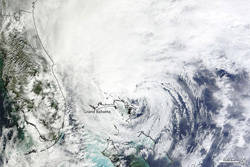
Sandy also caused the cancellation (and subsequent extension) of early-voting days and interrupted training of polling officials in some states, and her impact on voting day may be considerable even though her whirlwind tour is over. One potential effect could be that fewer voters will be able to get to the polls in hard-hit portions of the Northeast and mid-Atlantic, either due to transportation issues, damage to polling venues, power outages, or other hardships. This probably won’t change the election’s outcome, as Obama has a safe lead in most of the affected states. However, his popular vote might be adversely impacted, and thus accentuating the significance of the electoral college. Additionally, polling and media coverage of the campaign has been cut back. Some organizations have temporarily suspended their polling, and with the news media tabbing Sandy as the new “it girl,” the presidential candidates were sent to the fourth estate’s back burner, at least for a few days, as notedby media reporter Howard Kurtz:
Still, the greatest impact may be on public attention. Go to any news website or flip on any cable news channel, and Sandy is the dominant story by far. No one is talking about tax cuts or unemployment or immigration. Television has a tendency to overhype major storms, but given the breadth and destructive power of Sandy, the saturation coverage seems to match its magnitude.
It’s also worth considering what effect Sandy will have on voters’ thoughts about climate and where the two candidates stand on climate change. New York City Mayor Michael Bloomberg cited Sandy in particular and climate change in general in his endorsement of Obama:
The devastation that Hurricane Sandy brought to New York City and much of the Northeast—in lost lives, lost homes and lost business—brought the stakes of Tuesday’s presidential election into sharp relief. . . .
Our climate is changing. And while the increase in extreme weather we have experienced in New York City and around the world may or may not be the result of it, the risk that it might be—given this week’s devastation—should compel all elected leaders to take immediate action. . . .
When I step into the voting booth, I think about the world I want to leave my two daughters, and the values that are required to guide us there. The two parties’ nominees for president offer different visions of where they want to lead America. . . .
One sees climate change as an urgent problem that threatens our planet; one does not. I want our president to place scientific evidence and risk management above electoral politics.
If many other voters share Bloomberg’s perspective that immediate action on climate change is necessary and the President is more likely to take that action, then Barack and Mitt may come to see Sandy as the October surprise that decided the election.
Wild Weather Comes to NCAR
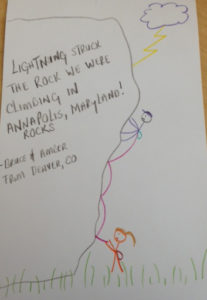
A new exhibit exploring the power of weather and the stories behind it opened earlier this month at NCAR’s Mesa Lab in Boulder, Colorado. Spark, the group that oversees science education at UCAR, created the exhibit with input from scientists, engineers, designers, and writers.
“Weather is a fascinating topic and it affects us all,” comments Rajul Pandya, director of Spark. “In the new Weather Gallery, visitors can touch clouds, make forecasts, and learn how scientists understand weather using special instruments and computer simulations.”
The NCAR Weather Gallery joins existing exhibits like an eight-foot-tall tornado, a microburst generation tank, and a display that shows current wind speeds measured on top of the building. One of the new features is the interactive, “Tell Your Weather Story,” which gives visitors the opportunity to describe and post their own experiences on weather.
It took about 20 months to plan and develop the exhibit from start to finish. To begin the process, an advisory committee met to decide what topics the exhibit should cover and what they wanted visitors to experience. They came up with a plan that included five content sections and several different ways of delivering information, which included hands-on interactives, large mural photos, panels with pictures and text, and touch screens with games and videos.
Since the exhibit opened on 10 October, the Mesa Lab has had approximately 2,000 visitors, with at least half that number spending time in the exhibits. About 15,000 people a year attend scheduled programs at lab, including 10,000 K-12 students and teachers who take classes and go on tours, as well as 5,000 in special groups and public tours.
“People are really excited about the new exhibit. Visitors love all of the opportunities to play with the hands-on stuff, and it’s been fun to see groups of visitors interacting with each other as they explore different parts of the exhibit,” says Becca Hatheway, NCAR exhibit manager. “UCAR and NCAR staff members are also excited to see something new in this space. I’ve seen just as many staff spending time in the exhibits as I have seen visitors. So I guess we’re all excited to learn more about the weather.” The visitor center at the Mesa Lab is open to the public year round and offers free exhibits about weather and climate, a gallery featuring local artists, an outdoor weather trails, and more. For more information visit the Spark web site.
And speaking of Spark, today (Saturday, 27 October) is UCAR’s Super Science Saturday from 10 a.m. to 4 p.m.–a chance for the whole family to visit the labs and combine science with some Halloween fun. There’s a preview video at the Spark home page:
Help Us Get Dressed for Success in Austin
What comes to mind when you think about the AMS? Can you express it with an interesting and eye-catching graphic?
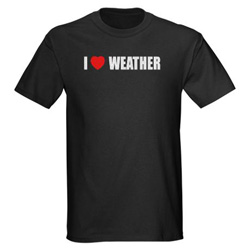
If so, then we have a contest for you: the Society is looking for a member to create an original design for a tee-shirt that represents the mission of the AMS. The winning shirt will be sold at the upcoming Annual Meeting in Austin, and the designer of the chosen shirt will receive free registration to that meeting. And as an added bonus, it’s all for a good cause: proceeds from sales of the shirts will be donated to the AMS Student Travel Grant fund, which helps senior undergraduate and graduate students attend AMS meetings.
The deadline is November 9, so it’s time to start thinking creatively, and then send your idea to [email protected]. The complete rules for the contest can be found here.
These Observations Get Our Stamp of Approval
The scientific benefits of Earth observation are well known in the atmospheric sciences. But there’s an artistic side to such observations, too, which is spectacularly depicted in the U.S. Postal Service’s new Earthscapes stamps, released last week in celebration of National Stamp Collecting Month and featuring images shot aloft from a variety of platforms, from a micro-light kite to satellites in space.
The set of 15 different stamps depicts natural, agricultural, and urban scenes from across the country. The Service’s contracted photo editors and researchers culled hundreds of images, which USPS Art Director Howard Paine narrowed down to the final 15. Some photos were taken by people in private planes and helicopters; others were taken by unmanned instruments, including the one below of the volcanic crater of Mount St. Helens in Washington, which was captured in 1999 by NASA’s Landsat 7. Other images in the set include ice breaking off from Alaska’s Bear Glacier, a cherry orchard in Wisconsin, and a cranberry bog in Massachusetts.
Along with the forever stamps, other Earthscapes collectibles for the philatelist include a first-day cover set, a jigsaw puzzle, and an Earthscapes ceremony program.
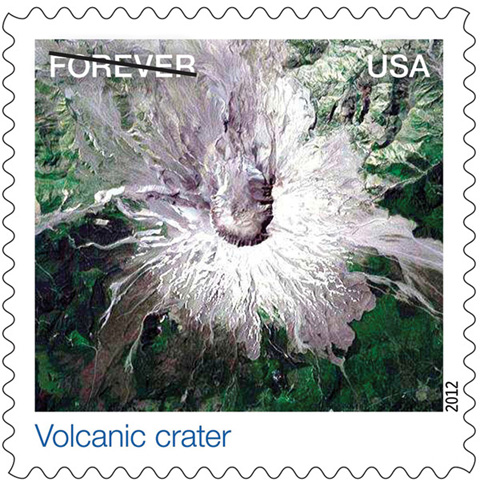
Congressional Staff Hear Unified Call for a U.S. Weather Commission
by Ellen Klicka, AMS Policy Program
Courage is what it takes to stand up and speak; courage is also what it takes to sit down and listen. – Winston Churchill
The weather enterprise in the U.S. is a diverse community of government agencies, the private sector, academic institutions, and nongovernmental societies with a common interest to foster resilience to weather events from the national level to the smallest village. The effectiveness of the enterprise is affected by its members’ ability to listen to the needs of the users of weather products and services and speak up to ensure those needs are met.
On Thursday, Congressional staff members packed into the House Science Committee Hearing Room with representatives from NOAA, scientific societies, private companies, universities and other interested parties to discuss the state of the weather enterprise. The agenda centered on the proposed creation of the first U.S. Commission on Weather Policy.
The briefing, sponsored by the University Corporation for Atmospheric Research (UCAR) and the Weather Coalition, was prompted by recommendations the National Academy of Science Board on Atmospheric Sciences and Climate (BASC) made in an August report, Weather Services for the Nation: Becoming Second to None. The BASC report drew upon lessons learned from the National Weather Service (NWS) modernization project completed in 2000 and provided guidance on future improvements to the NWS.
One recommendation focused on engaging the entire weather enterprise to develop and implement a national strategy to strengthen products and services the public depends upon. “The greatest national good is achieved when all parts of the enterprise function optimally to serve the public and businesses,” the report stated. The Weather Coalition, in turn, recommended the establishment of a commission.
The briefing also followed a Town Hall meeting at the 2012 AMS Annual Meeting in New Orleans that solicited input from AMS members regarding what messages the weather enterprise needs to send to Washington.
Panel speakers included John Armstrong, chairman of the BASC report committee; Bill Gail, co-founder and Chief Technology Officer of Global Weather Corporation; Pam Emch, Senior Staff Engineer/Scientist, Northrop Grumman; and Tom Bogdan, president of UCAR. Moderator Scott Rayder, Senior Advisor to the President, UCAR, asked the panelists to lay out the case for chartering such a commission, which would likely be composed of top officials from the Legislative and Executive branches.
The commission would provide “strong and consistent advocacy” for the weather enterprise’s priorities in an organized manner, Dr. Emch said. Dr. Gail emphasized the opportunity afforded by a thriving private sector within the weather enterprise even during a strained period in the national economy. Dr. Armstrong provided a reminder that today’s information-centric society continually raises the public’s expectations of the accuracy and convenient delivery of the enterprise’s products and services.
An e-mail invitation described the purpose of the proposed commission. “At a time of fast-changing technological innovations, the commission would advise federal policy makers on setting priorities for improving research and forecasts thereby creating a more weather-proof nation. Its goal is to ensure effective spending on the nation’s weather research and related systems, while minimizing the impacts of major storms.”
The proposed commission would follow the structure of the U.S. Commission on Ocean Policy, chartered by the Oceans Act of 2000.
Before a weather commission launches, specific measurable criteria need to be developed to gauge its effectiveness. Will objectives encompass securing steady or increased federal funding? Are any new programs or councils called for? Will expectations or guidelines be set as to what the private and academic sectors would contribute and receive in return?
According to Dr. Bogdan, a near-term next step might take the form of a second briefing on Capitol Hill, during which end users of weather forecasts and warning information could convey their needs and how they would benefit from a U.S. Commission on Weather Policy. Supporters of the proposed commission also will need to identify members of Congress willing to sponsor a bill that would charter the commission. If legislation is introduced, the sponsors would have their turns to courageously speak up for the weather enterprise and ask their colleagues on the Hill to have the courage to listen.
AMS Dedicates 45 Beacon Room to Joanne Simpson
Last week, AMS held a ceremony at our 45 Beacon Street headquarters in Boston to celebrate the life and accomplishments of pioneer scientist Joanne Simpson. The AMS Council, AMS staff, and members of Joanne’s family gathered to watch the unveiling of her portrait that hangs in what is now “The Simpson Room.” The first woman to ever receive a Ph.D. in meteorology and first female AMS president, Joanne’s numerous contributions to science and the Society were lauded by current AMS President Louis Uccellini and Past President Peggy Lemone:
One of Joanne’s daughters was in attendance and Joanne’s husband, Robert Simpson, and three other children were able to view the ceremony through video conference. Robert had this to say:
On behalf of the Simpson family at large, I want to express our deep appreciation to the Society for its special recognition of Joanne Simpson with this unique posthumous award. All of us appreciate that you chose this unique way of further honoring Joanne. She served AMS nobly and effectively throughout her career—a career distinguished not only by her seminal contributions to tropical meteorology and the general circulation of the globe, but also her dedication to the role of women in science, showering them with encouragement, assistance in their efforts, and championing their struggle for recognition.
Simpson concluded by noting if Joanne had been given a choice she probably would have treasured this recognition by AMS even more than she did her Carl Gustaf Rossby gold medal award.
World Record Temperature Overturned by Climatologists
“I think he read on the wrong side of the [thermometer] scale, and so was off by five degrees of Celsius. If you adjust for that, there was no 136-degree Fahrenheit temperature at El Azizia, Libya, in September 1922. Based on some really involved detective work, [a committee of experts] decided that this reading simply is not valid. It’s not the world’s hottest temperature.”
–Randall Cerveny, Arizona State University, one of the co-authors of the BAMS article published on-line today, speaking in this video available on Vimeo.
Broadcasters Bring it to Boston
Last week more than two hundred broadcasters made their way to the 40th Conference on Broadcast Meteorology in Boston. This was an impressive number of attendees given the unusual timing for a broadcast conference. With the approach of the peak of hurricane season, not to mention Hurricane Isaac, it’s typically not an ideal time for broadcasters to be away from their home bases. Yet, the chairs of the conference felt the significance of the 40th anniversary required a city of equal weight and were determined to make Boston work.
Here co-chair Rob Eicher, meteorologist at WOFL in Orlando, explains:
As one of America’s oldest cities, Boston is rich in meteorological history that goes back to 1774 when John Jeffries began taking daily weather observations. Co-chair Maureen McCann, meteorologist at KMGH in Denver, talks about this as well as other touchstones that make the city a meteorological hub:
Broadcasters attended two and half days of presentations covering topics such as regional weather, new technology, and science and communication. KWCH Wichita Meteorologist Ross Janssen, who had his first experience working as a meeting chair, talks about the hard work as well as the benefits of bringing the broadcast community together at an event like this:
A short course “From Climate to Space: Hot Topics for the Station Scientist,” covered both climate change and astronomy, and concluded with a nighttime viewing session at the Clay Center’s observatory in Brookline. Another highlight was a panel discussion on the emergent use of social media in the broadcast community. Afterward attendees made their way to Fenway Park for a night of baseball. If only the Red Sox hadn’t squandered their early lead to the Angels it would have been the perfect way to wrap up the Boston event.
AMS Releases Revised Climate Change Statement
The American Meteorological Society today released an updated Statement on Climate Change (also available here in pdf form), replacing the 2007 version that was in effect. The informational statement is intended to provide a trustworthy, objective, and scientifically up-to-date explanation of scientific issues of concern to the public. The statement provides a brief overview of how and why global climate has changed in recent decades and will continue to change in the future. It is based on the peer-reviewed scientific literature and is consistent with the majority of current scientific understanding as expressed in assessments and reports from the Intergovernmental Panel on Climate Change, the U.S. National Academy of Sciences, and the U.S. Global Change Research Program.
“This statement is the result of hundreds of hours of work by many AMS members over the past year,” comments AMS Executive Director Keith Seitter. “It was a careful and thorough process with many stages of review, and one that included the opportunity for input from any AMS member before the draft was finalized.”
The AMS releases statements on a variety of scientific issues in the atmospheric and related sciences as a service to the public, policy makers, and the scientific community.